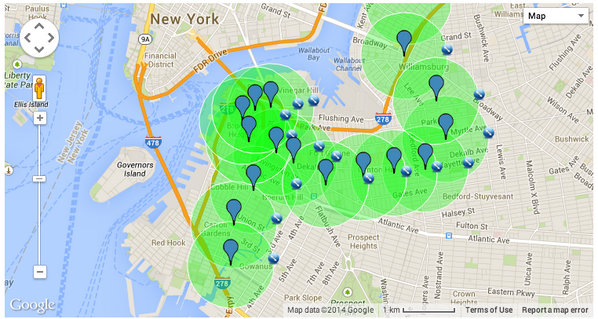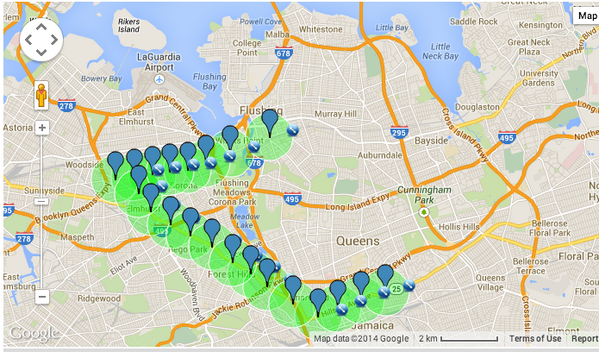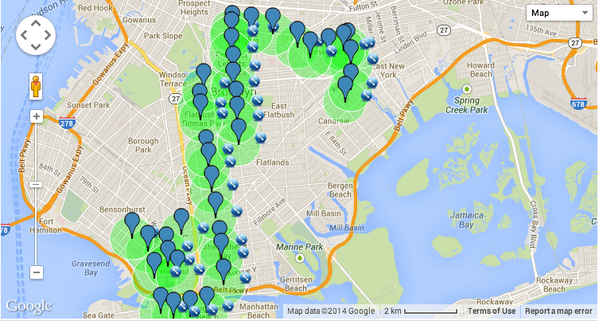
Is this waterfront street car a ‘cool idea’ or the G train but worse? (Via Next New York)
And yet, it won’t die. As we learned on Friday, a new conglomerate of — transit advocates? people who want newspaper headlines? — has proposed studying a Brooklyn waterfront streetcar. Sally Goldenberg and Dana Rubinstein broke the story, and it’s a gem. As you will not surprised to hear in New York City 2015, it’s an idea spurred on by developers rather than people with actual transit knowledge, and the basis for the support is because it sounds cool.
If you think I’m kidding, I’m not. Here’s what David Lombino, the Director of Special Projects at Two Trees had to say: “It’s a cool idea. We’re a supporter. Could be transformative for Brooklyn and Queens someday. We’ll see.”
It’s a cool idea. Now that’s a great basis for transit development, especially for a project that would require the upfront investment that a new-to-New York transit mode such as a streetcar would present. The Capital New York reporters had more:
While the waterfront has decent subway connections to Manhattan, the paucity of north-west transportation connecting Astoria to, say, Red Hook, has long been a source of frustration. The G train alone just doesn’t cut it. And so an advisory committee of some of the city’s more prominent developers, transportation experts and community organizers has taken shape in an effort to find a remedy. Together, they’ve commissioned HR&A Advisors (planning commissioner Carl Weisbrod’s former employer) to study the economic impact of a streetcar or lightrail connecting Brooklyn’s Sunset Park to Astoria, Queens. The route could include hot housing markets like Red Hook, Williamsburg and Downtown Brooklyn, as well as areas where commercial outfits and offices are setting up shop, such as Long Island City and the Brooklyn Navy Yard.
…The committee includes Regional Plan Association president Tom Wright, traffic engineer [Gridlock] Sam Schwartz, Transportation Alternatives executive director Paul Steely White, Downtown Brooklyn Partnership president Tucker Reed, Industry City executive Andrew Kimball, urban planner Alex Garvin, Fifth Avenue Committee executive director and City Planning Commission member Michelle de la Uz and Red Hook Initiative founder Jill Eisenhard. Schwartz will conduct the feasibility study.
“I’m interested in seeing how the research comes out,” Wright said. “There’s the possibility of both connecting to other existing transit services—bus, rail and ferry—and complementing other proposals.”
The project’s advocates have no idea what the final recommendations will reveal, but already their claims are a mass of contradictions. They seem to feel that Industry City, with nearby subway service from the N, R and D trains, is isolated while they don’t know who would run — or more importantly fund — light rail. “One of the attractive alternatives is this wouldn’t necessarily be run and operated by the MTA, but that it’s open for a concession operation, which would probably be a good thing,” RPA President Tom Wright said.
It’s hard to know where to begin with this. Besides my belief that “it’s a cool idea” is never the basis for transit investment, I’m highly skeptical of modes of transit that aren’t operated by — or at least integrated into — the MTA network. Setting aside the fact that we don’t know who feels that subways that are 7 stops from Times Square aren’t sufficient for service to Industry City or how many people would actually need to go from Astoria to Red Hook or Long Island City to Industry City on a daily basis, it raises a red flag any time we introduce a second fare into the travel equation from areas that aren’t really that transit-starved in the first place.
Based upon current transit operations, our goals should be to improve current options. The B61, for instance, is painfully slow through Red Hook to its subway connections on either side, and it serves low-income workers who have few other options. Without figuring out a way to upgrade these transit services while introducing a “cool” waterfront streetcar because it fits with developers’ real estate ambitions would raise serious concerns about transit access and investment. If this sounds like a class issue, well, that’s because it is.
This isn’t to say that inter-borough connections aren’t sufficient. They suffer from the same historical problems that plague the subway and bus systems. But if advocates are lining up behind a waterfront study because everyone is only know just realizing that it might be an 8-10 minute walk from Two Trees’ Domino Sugar Factory development to the J/M train or an overcrowded L, well, I worry about what that means for better transit access for the rest of New York City. Let’s get it right because access matters for everyone and not because the company sinking money into areas with good views but long walks to the subway thinks it’s a “cool idea.”



